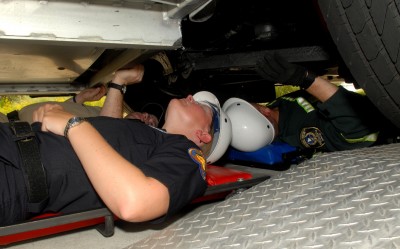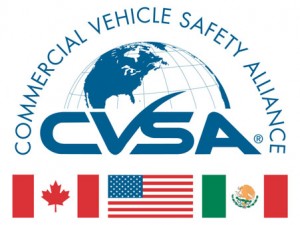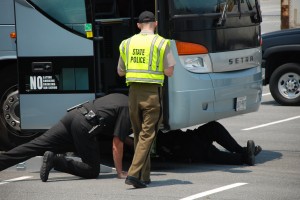
By Glenn Swain
Deadly bus crashes this year have made news headlines, thrusting bus safety into the forefront. At the same time the Commercial Vehicle Safety Alliance has been shoved into the limelight as well.
 It is the CVSA’s job to promote commercial motor vehicle safety and security by providing leadership to enforcement, industry and policy makers. CVSA member jurisdictions are represented by various departments of transportation, public utility and service commissions, state police, highway patrols and other transportation officials. With the help of nine different committees, the CVSA develops all inspection procedures and certifies inspection agents, which now number about 12,000 nationwide. But only a small percentage of those agents are certified to perform bus inspections. The international not-for-profit organization also has several hundred associate members.
It is the CVSA’s job to promote commercial motor vehicle safety and security by providing leadership to enforcement, industry and policy makers. CVSA member jurisdictions are represented by various departments of transportation, public utility and service commissions, state police, highway patrols and other transportation officials. With the help of nine different committees, the CVSA develops all inspection procedures and certifies inspection agents, which now number about 12,000 nationwide. But only a small percentage of those agents are certified to perform bus inspections. The international not-for-profit organization also has several hundred associate members.
The CVSA works closely with federal agencies like the Federal Motor Carrier Safety Administration, which actually writes the rules and distributes grant money to the states to the tune of about $300 million a year.
Stephen A. Keppler, CVSA’s executive director, welcomes the CVSA’s higher profile position, believing the more word gets out on commercial vehicle safety the better. But with the extra attention has come criticism of the organization from honorable bus operators that the CVSA is not directing enough of its resources to unscrupulous operators. Speaking last week to BUSRide, Keppler addressed some of the issues, explaining how the CVSA has stepped up inspections while at the same time reminding the bus industry that there are far more truck accidents than bus crashes.
“By and large the bus industry has a good safety record,” Keppler told BUSRide. “There are a couple hundred people killed in bus crashes each year and there are 10 times as many killed in truck crashes. It’s commensurate with the risk”

Keppler says the CVSA is trying to have more agents certified to perform bus inspections, but admits it is an uphill battle at the moment.
“It is back to a resources issue,” Keppler said. “We would like to have everyone certified, but it is several weeks of intensive on-the-job training. It doesn’t happen over night and it takes money, and the states are in tight budgets right now.”
Some bus operators have suggested that CVSA agents have to meet inspection quotas, claiming that is one reason some of the more established and compliant operators continue to be inspected while the smaller, unsafe carriers roll free.
“That’s a misnomer,” Keppler said of agent quotas. “We know how many inspections they are doing, but there are no targets.”
According to Keppler, the CVSA is lobbying Congress to roll back a law prohibiting a bus from being stopped unless there is an imminent hazard.
“They want to be able to pull them into a roadside inspection booth,” said Christopher Crean, Peter Pan Bus Lines’ vice president of safety and security. “If an inspection station is open they want to be able to stop a bus. We already instruct our drivers to stop if it says commercial vehicles must stop. Most of the time we either get a safety inspection or we get flagged through.”
Crean says cities and states have different rules about commercial vehicles stopping at inspection booths, so to simplify the process Peter Pan drivers are trained to pull the bus over.
“It’s too confusing, so our policy is stop,” Crean said. “The worst that’s going to happen is there is going to be subject to a log or safety audit. The roadside inspection is part of our security protocol. In the event there should be an issue or problem aboard a coach, there are law enforcement officials at these areas.”
Keppler said that while enforcement has quadrupled in the last year throughout the U.S., the northeast has been the target of repeated inspections, since a majority of the high profile bus crashes occurred there this year.
“The amount of inspection activity, especially in the northeast, has increased exponentially,” Keppler said. “They are being very vigilant within the constraints they are dealing with. There is a lot of enforcement going on, I can promise you that.”
Keppler strikes a conciliatory tone around the continued debate with bus operators.
“Our success is really due to cooperation by industry and government,” he said. “Industry people are our members and they have votes on all of our committees just as government does. While at times we may differ with the bus industry on issues, collectively we all have the same goal for safety. This en route issue is something that we are at odds against with the industry, but by and large we work very collaboratively because we do have the same goal, and that’s safety.”
On Monday Keppler received an update on a possible provision for the surface transportation bill that would allow the CVSA to stop buses at inspection stations for no apparent reason. Don’t expect quick passage, he said, because the current conversation in Congress is being dominated by the debate over payroll tax credits.
“I just spoke to our congressional staff and it looks like the Senate Commerce Committee will be marking up the bill December 14,” he said. “The bill may get introduced by the end of the year, but there is not enough time to get it done by then. We’re still hopeful the bill will be introduced for the House and Senate before the end of the year. They’ll have a couple of months of debate before the bill’s extension expires in March.”
